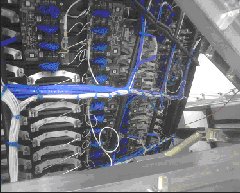The special materials used in these highly specialized constructions include aluminium, titanium, high-module carbon fibres and special material.
The AMS (anti-matter spectrometer) space-flight experiment was a huge success! The first solution developed by ISATEC demonstrated its ability to meet all of the stringent precision and load requirements imposed by NASA during a 10-day space shuttle flight (STS91) in 1998.
The experimental solution is currently being modified for extended, stationary operation in the International Space Station (ISS) and equipped with additional detectors (AMS2).
October 16, 2007 was a very special day for ISATEC. On that day, the largest of the new detectors were presented to CERN, coordinator of the space-flight experiment, after several years of development and production. It was a festive occasion for everyone involved – honoured at a celebration at the Physics Institute at the RWTH Aachen University. Known as a transitional radiation detector (TRD), the device was presented in an impressive live demonstration, showing the assembled visitors that we are struck by a particle of outer space radiation every few seconds even beneath the metal roof of the institute building. The detector is expected to register a much stronger particle stream in outer space due to the absence of shielding and atmospheric attenuation.
